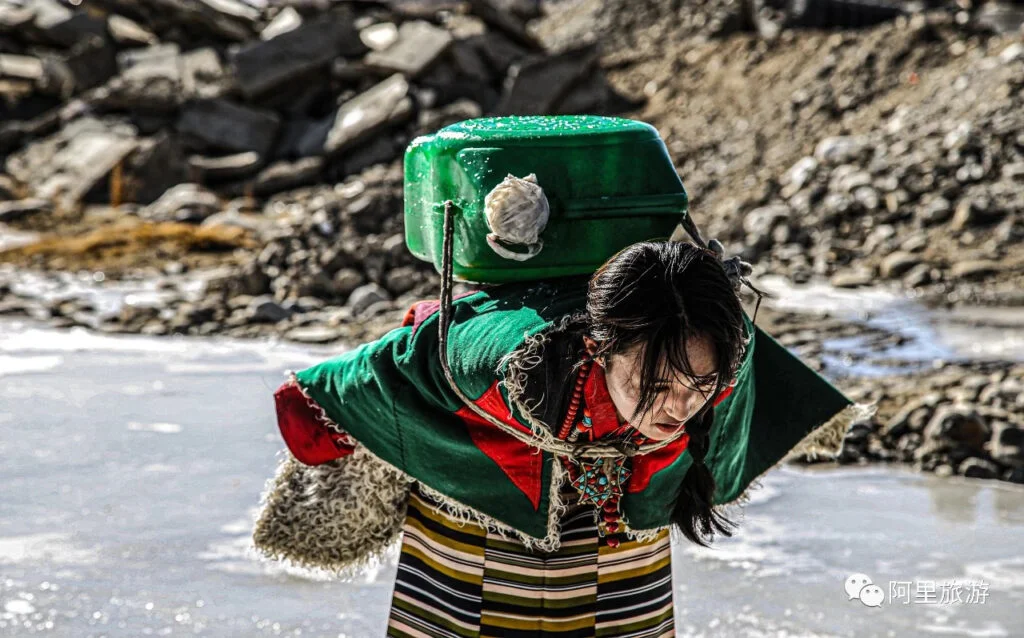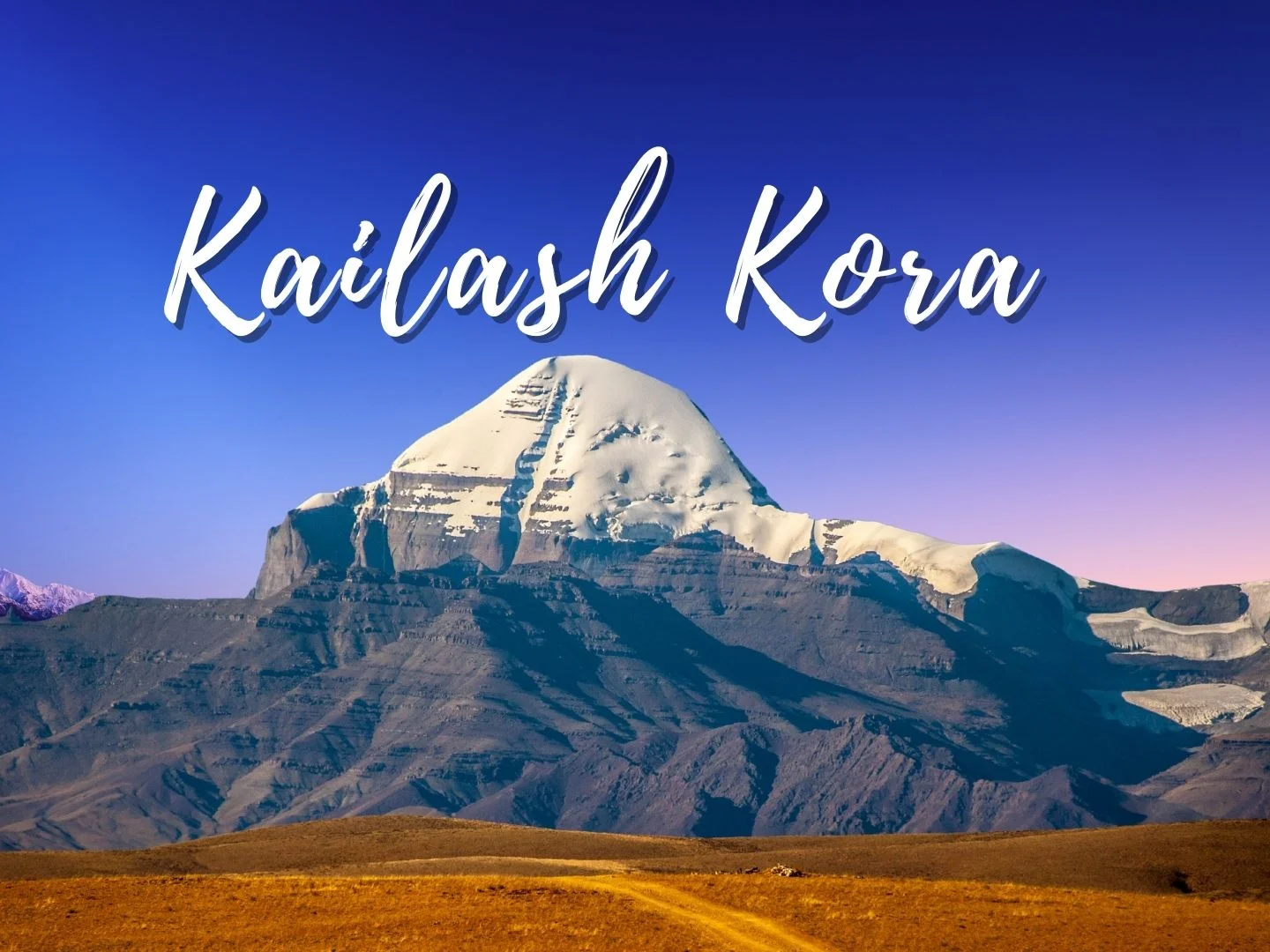Langchen Tsangpo, also known as the “Sutlej River,” is a captivating river nestled in the northwest of Zanda County. Its name, “Langchen Tsangpo,” translates to “Elephant River” in Tibetan, but it’s also known as “Xiangquan River” and “Langchu River.” In the mesmerizing Ali folk song, “Praise to the Four Rivers of Ali,” the Xiangquan River is described as follows: “The green Langchen River flows in the Zada territory. The reason why the Guge regime is so strong depends on the nourishment of this river.”
The Langchen Tsangpo (Sutlej River), often referred to as the “River of the Gods,” holds a special place in the hearts of locals in Ali, and it has given rise to intriguing legends. According to Tibetan Buddhist scriptures, the Gang Rinpoche Peak is surrounded by four mythical creatures – a lion, a white elephant, a swift horse, and a peacock.
These creatures, moved by the recurrent droughts in the Ali region, continuously spout water from their mouths, forming what we now know as the Lion Spring River, Elephant Spring River, Horse Spring River, and Peacock Spring River. These mighty waters traverse through mountain gorges, valleys, and expansive plains, eventually merging into the boundless sea.
Today, these captivating stories about the Langchen Tsangpo (Sutlej River) are beautifully depicted on the murals of numerous local monasteries, preserving the river’s significance for future generations.
Unveiling the Journey of Langchen Tsangpo
Langchen Tsangpo originates from Pulan County, meandering westward from its source to Menshi. Along its course, it passes through significant landmarks such as the Tuolin Temple in Zada, the ruins of the Guge Kingdom, Tholing, and the hometown of the great translator Rinchen Zangbo. From here, the river continues its majestic journey westward, cutting through the Himalayas and eventually flowing into India, where it adopts the name “Sutlej River.”
In Pakistan, it merges with the Chenab River to form the Panjala, which ultimately flows into the Indus River. With a total length of 1,450 kilometres, Langchen Tsangpo is a remarkable natural wonder.
A River of Riches
Langchen Tsangpo boasts impressive statistics, with a length of 309 kilometres, an annual runoff of 900 million cubic meters, and a drainage area covering 22,760 square kilometres. The basin falls within the semi-arid to arid climate zone of southwest Tibet. Its upper reaches are marked by the development of glaciers and glacier landforms, featuring loess-like lake strata. As the river progresses downstream, it gives way to canyons. Notably, Tibetan croaker (yellow croaker) is found in Hanoi. The basin is blessed with natural pastures and farmland, providing abundant water and grass. It’s even rumoured that those who drink the water from this river gain the strength of elephants.

What to Explore
Zada Suspension Bridge
One of the key attractions along the Langchen Tsangpo River is the Zada Suspension Bridge. This bridge spans the Langchen River, with a total length of 20 meters and a width of 1.7 meters. The bridge is constructed entirely from six layers of logs, cantilevered towards the centre of the river. These layers are interconnected by horizontal logs, with six logs densely paved on each layer. The middle span extends for 8 meters and connects to the cantilevered sections on both ends through six long logs.
To strengthen the bridge, stone bridgeheads were erected on both sides of the river, and wooden beams were firmly pressed down. Such suspension bridges are commonly found in areas with high mountains, deep waters, and challenges in piling for traditional bridges. When rivers are wide, gentle in flow, and not too deep, bridge piers may be added to support the cantilever sections.
Zada Earth Forest and Tulin Monastery: An Exploration Along the Langchen Tsangpo
The Langchen Tsangpo (Sutlej River) basin stands as the birthplace of ancient civilization in western Tibet, a region marked by its grandeur, now preserved in memory but never forgotten. Geographers consider the Langchen Tsangpo (Sutlej River) as a lifeline, breathing life into the barren lands of Ali. A striking example of its nurturing power is Zada County. Thanks to the Langchen Tsangpo (Sutlej River), this rocky wilderness has been transformed into a vibrant landscape.
The Langchen Tsangpo – Cradle of Western Tibetan Civilization
Zada, translated as “a place with grass downstream” in Tibetan, is renowned for its spectacular views and is one of the key origins of traditional Tibetan folk dance, including the ancient “Gu-ge Xuan” dance, which has a history spanning over a millennium. The most captivating scenery that encapsulates the beauty of Zada is Tulin Gully. Upon entering Tulin Gully, one is mesmerized by the vast expanse of earth forest. In the glaring sunlight, these towering earthen pillars resemble ancient fortresses and watchtowers, presenting a vast and desolate landscape.
Zada County – Transformed by Langchen Tsangpo’s Grace
Over a million years ago, Zada Earth Forest was a massive lake stretching over 500 kilometres. However, the Himalayan orogeny caused the lakebed to subside, and the wind and rain eroded the exposed loess soil, gradually sculpting the awe-inspiring natural earth pillars we see today.
Beneath this contemporary earth forest lies a dense network of folds and ravines. With each heavy rain, this over 30-kilometer-long gully could transform into a flowing river, serving as a “moat” to protect Zada County. Passing through Tulin Gully, you’ll encounter the quaint Zada County town.
Tulin Monastery – A Glimpse into Ancient Spirituality
This small town exudes a sense of serenity and spaciousness. As you walk along the bare earth streets, you’ll soon come across the iconic elephant sculpture at Tulin Square, marking Tulin Monastery, a sacred place of pilgrimage for the people of Ali. In the early 11th century, Tulin Monastery was constructed under the auspices of the Guge King, Yesiwo, making it one of the earliest monasteries in Tibet.
Owing to the fervent support of the ruling powers at that time, Tulin Monastery became the Buddhist epicenter for the entire Ali region. The intact Tulin Monastery once comprised the Jasa Temple, Bai Temple, Eighteen Arhats Temple, Maitreya Buddha Temple, Guardian Temple, Adisha Temple, and Rinchen Sangbo Translators’ Temple, along with numerous monks’ quarters and stupa forests, presenting a grandeur beyond compare.
The Magnificence of Tulin Monastery’s Past
Regrettably, due to natural factors and human interference spanning several centuries, the former magnificence of Tulin Monastery is now but a distant memory. At present, only 108 earthen stupas, known as the “108 Stupas,” survive along the banks of the Langchen Tsangpo (Sutlej River). According to locals, when the monastery was initially built, there were over 500 stupas.
The Langchen Tsangpo Basin – A Tale of Nature and History
However, most of them were lost due to land collapses caused by the rising waters of the Langchen Tsangpo (Sutlej River). In 1996, recognizing the profound historical significance of Tulin Monastery, it was designated as a “National Level I Cultural Heritage Protection Unit,” with dedicated efforts in place to preserve its rich heritage. The Langchen Tsangpo (Sutlej River) basin is not just a geographical marvel but a cradle of ancient civilizations, where nature and history coalesce to tell a compelling story of time and transformation.
Tour Tips
- Historical Significance: The river sections and river basins in Ngari are at the heart of the ancient Zhangzhong civilization. Iconic structures like Dawa Qionglong’ou Castle, Pewang Wuze Castle, Biti Castle, Qumudi Castle, Qimei Gawu Castle, and the renowned ancient Gezhabrang Castle, all find their roots in the Langchen Tsangpo River Basin. This makes it the cradle of ancient civilization in western Tibet.
- A Spiritual Hub: The region also served as a vital transmission area for Tibetan Buddhism during the later Hong period. It retains the most complete traces of the Zhangzhung civilization and Tibetan Buddhism from that era, featuring castles, palaces, cave dwellings, murals, and more.
- Cultural Crossroads: Due to its proximity to South Asia and Central Asia, this river basin has been a hub for the exchange of Chinese and foreign civilizations. It continues to be of great interest to domestic and international academic circles.
In conclusion, Langchen Tsangpo, the Sutlej River, is a treasure trove of natural beauty, history, and cultural significance. Its journey through Tibet, India, and Pakistan is a testament to the ever-changing landscape of this region. Exploring its wonders will undoubtedly be an enriching and unforgettable experience.
Frequently Asked Questions
1. How do I get to Langchen Tsangpo?
Langchen Tsangpo can be reached via Zanda County in the northwest of Tibet. You can access the region through various transportation modes, including roads and, in some cases, by air.
2. What is the best time to visit Langchen Tsangpo?
The best time to visit Langchen Tsangpo is during the spring and summer months, from April to September when the weather is more favourable and the landscape is lush and vibrant.
3. Are there guided tours available for Langchen Tsangpo?
Yes, there are several tour operators and agencies that offer guided tours to Langchen Tsangpo. These tours can provide valuable insights into the region’s history and culture.
4. Is Langchen Tsangpo suitable for outdoor activities?
Absolutely! Langchen Tsangpo offers excellent opportunities for outdoor enthusiasts. You can engage in activities such as trekking, birdwatching, and photography to make the most of your visit.
5. What should I pack for a trip to Langchen Tsangpo?
When visiting Langchen Tsangpo, it’s essential to pack appropriate clothing for varying weather conditions, comfortable walking shoes, sunscreen, and a camera to capture the breathtaking scenery.



